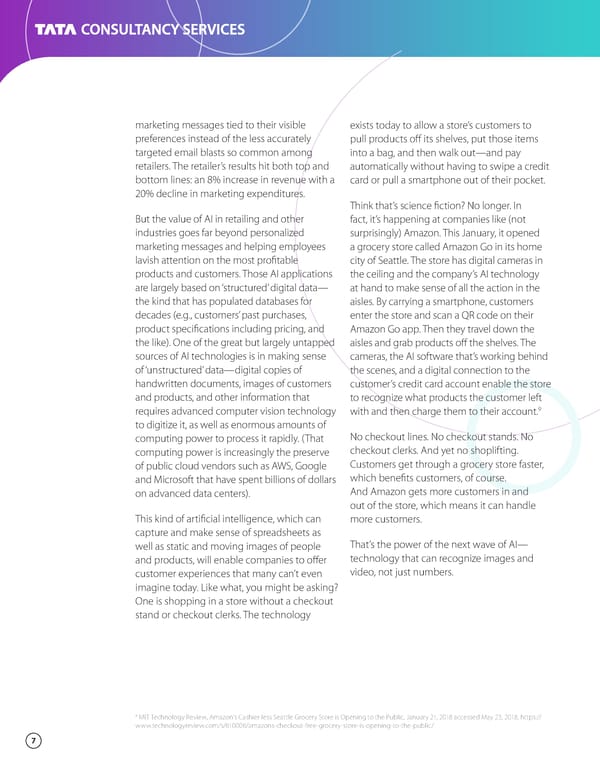marketing messages tied to their visible exists today to allow a store’s customers to preferences instead of the less accurately pull products off its shelves, put those items targeted email blasts so common among into a bag, and then walk out—and pay retailers. The retailer’s results hit both top and automatically without having to swipe a credit bottom lines: an 8% increase in revenue with a card or pull a smartphone out of their pocket. 20% decline in marketing expenditures. Think that’s science fiction? No longer. In But the value of AI in retailing and other fact, it’s happening at companies like (not industries goes far beyond personalized surprisingly) Amazon. This January, it opened marketing messages and helping employees a grocery store called Amazon Go in its home lavish attention on the most profitable city of Seattle. The store has digital cameras in products and customers. Those AI applications the ceiling and the company’s AI technology are largely based on ‘structured’ digital data— at hand to make sense of all the action in the the kind that has populated databases for aisles. By carrying a smartphone, customers decades (e.g., customers’ past purchases, enter the store and scan a QR code on their product specifications including pricing, and Amazon Go app. Then they travel down the the like). One of the great but largely untapped aisles and grab products off the shelves. The sources of AI technologies is in making sense cameras, the AI software that’s working behind of ‘unstructured’ data—digital copies of the scenes, and a digital connection to the handwritten documents, images of customers customer’s credit card account enable the store and products, and other information that to recognize what products the customer left requires advanced computer vision technology 9 with and then charge them to their account. to digitize it, as well as enormous amounts of computing power to process it rapidly. (That No checkout lines. No checkout stands. No computing power is increasingly the preserve checkout clerks. And yet no shoplifting. of public cloud vendors such as AWS, Google Customers get through a grocery store faster, and Microsoft that have spent billions of dollars which benefits customers, of course. on advanced data centers). And Amazon gets more customers in and out of the store, which means it can handle This kind of artificial intelligence, which can more customers. capture and make sense of spreadsheets as well as static and moving images of people That’s the power of the next wave of AI— and products, will enable companies to offer technology that can recognize images and customer experiences that many can’t even video, not just numbers. imagine today. Like what, you might be asking? One is shopping in a store without a checkout stand or checkout clerks. The technology 9 MIT Technology Review, Amazon’s Cashier-less Seattle Grocery Store is Opening to the Public, January 21, 2018 accessed May 23, 2018, https:// www.technologyreview.com/s/610006/amazons-checkout-free-grocery-store-is-opening-to-the-public/ 7
 Digital Transformation Starts with CX Page 8 Page 10
Digital Transformation Starts with CX Page 8 Page 10